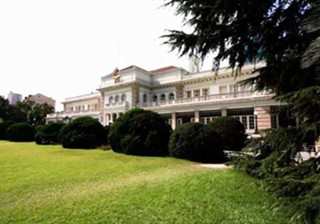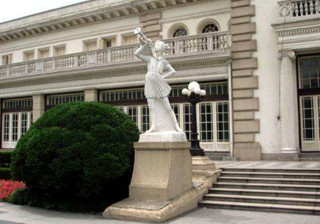- +86-13267351235
- info@globalstourtravels.com
The Shanghai Children's Palace sits at 64 Yan'an Xilu. Its main  building is a spot-lessly white structure constructed with marble shipped in from Italy. This magnificent building, the only marble building in Shanghai, is naturally called "the marble palace" by locals. The mansion interior has drawing rooms, both big and small, and over 20 bedrooms, each decorated with a different style and color scheme. The sumptuous furnishings and ornamentation are done in the style of ancient European palaces and are absolutely splendid. Legendary in it’s the result of an alcohol-fueled blunder. In 1919, Kadoorie's original home on Huangpi Nanlu was lost in a huge fire. Sadly, Kadoorie's wife died in the blaze when she attempted to rescue a female teacher locked inside. Distraught by his terrible loss, Kadoorie decided to temporarily return to London with his two children. Before he left, he entrusted the construction of his new house on Da Xilu (today's Yan'an Xilu) to his friend, architect Graham Brown. Little did Kadoorie know, Brown had developed was enough money to purchase 25 million kilograms of rice — enough rice to feed 140 thousand people for one year.
building is a spot-lessly white structure constructed with marble shipped in from Italy. This magnificent building, the only marble building in Shanghai, is naturally called "the marble palace" by locals. The mansion interior has drawing rooms, both big and small, and over 20 bedrooms, each decorated with a different style and color scheme. The sumptuous furnishings and ornamentation are done in the style of ancient European palaces and are absolutely splendid. Legendary in it’s the result of an alcohol-fueled blunder. In 1919, Kadoorie's original home on Huangpi Nanlu was lost in a huge fire. Sadly, Kadoorie's wife died in the blaze when she attempted to rescue a female teacher locked inside. Distraught by his terrible loss, Kadoorie decided to temporarily return to London with his two children. Before he left, he entrusted the construction of his new house on Da Xilu (today's Yan'an Xilu) to his friend, architect Graham Brown. Little did Kadoorie know, Brown had developed was enough money to purchase 25 million kilograms of rice — enough rice to feed 140 thousand people for one year.
When the Japanese army occupied Shanghai in World War Two, the Kadoorie residence was reduced to a den of monsters, becoming part of the Japanese military institution. After World War Two came to an end, the American military arrived on the shores of Shanghai. They were able to contact Kadoorie's two sons through the Swiss embassy, and requested that they return to into a severe alcoholic and he was forced to pass the project along to the Moorhead & Halse Company. Once rid of his responsibility, Brown never again inquired into its progress. When the new house was finished in 1924, Kadoorie returned to Shanghai finding both "a palatial new building and Brown lying dead drunk in a hospital bed." Caring for the new house required at least 30 to 40 servants. But, the biggest shock came when the building's contractor sent over the bill. The Kadoorie Palace cost an astronomical one million pieces of silver. At the time, that the marble palace. As they stepped into the house, the two Kadoories excitedly threw on all of the lights to celebrate the allied victory. While in Shanghai, they helped supply the allied troops with foodstuffs stamped with the letter K. As the story goes, the two brothers never touched the expensive food items themselves. After the Chinese Civil War, the Kadoorie family moved their enterprise out of Shanghai to Hong Kong. On May 31, 1953 Song Qingling suggested turning the marble palace into the China Welfare Association Children's Palace.
In 1979, Lawrence Kadoorie and his wife returned to Shanghai for a short trip. When catching sight of the Children's Palace, Elly's son is said to have excitedly exclaimed, "The marble building that my father loved so much has become a place of education for thousands of children".
Sir Kadoorie
At the end of the 19th century, Elly Kadoorie, like many Baghdadi  Jews before him, traveled from Bombay to do business in Hong Kong and Shanghai. Kadoorie is credited with opening Hong Kong's first consulting firm, and in 1926 the English King knighted him for establishing Shang-hai's Yucai Engineering School (today's Yucai Middle school) and contributed money to build the Shanghai's first hospital for treating tuberculosis. In the 1930's, Kadoorie's two grown sons Lawrence and Horace, aided their father in expanding his enterprises. The Kadoorie family businesses eventually expanded to the point where the Kadoorie name could be mentioned in the same breath as the wealthy and renowned Sassoons and the Hardoons, two of Shanghai's most powerful Jewish business families.
Jews before him, traveled from Bombay to do business in Hong Kong and Shanghai. Kadoorie is credited with opening Hong Kong's first consulting firm, and in 1926 the English King knighted him for establishing Shang-hai's Yucai Engineering School (today's Yucai Middle school) and contributed money to build the Shanghai's first hospital for treating tuberculosis. In the 1930's, Kadoorie's two grown sons Lawrence and Horace, aided their father in expanding his enterprises. The Kadoorie family businesses eventually expanded to the point where the Kadoorie name could be mentioned in the same breath as the wealthy and renowned Sassoons and the Hardoons, two of Shanghai's most powerful Jewish business families.
In October 1938, waves of Jewish refugees from Europe began flooding into Shanghai. Kadoorie took initiative to convene an aid conference and set up Shanghai's community groups and social relief organizations inside his marble palace. Not only did Kadoorie donate huge sums of money, he also funded the construction of the Jewish Youth School, which only accepted children of European refugees. When the Pacific War began in 1941, the generous Kadoorie family suffered calamity. As the Japanese marched into the European concession, the Kadoories were kicked out of their homes and detained inside Hong Kong's Stanley Concentration Camp. Afterwards, they were brought back to Shanghai where they were shut inside the Zhabei Concentration Camp. Sustained with only a daily ashtray of rice, cold, sick, and starving, Elly Kadoorie was tormented to death. His wealth and enterprises were plundered by the Japanese, and his holdings in Hong Kong and South East Asia were wiped out.